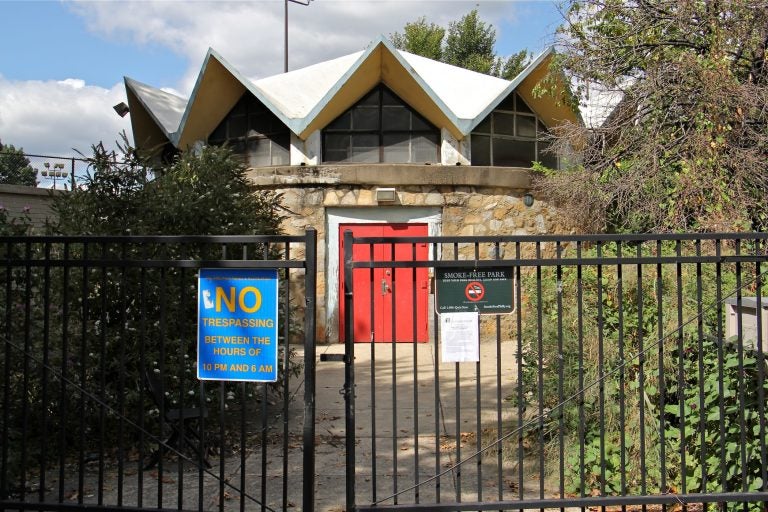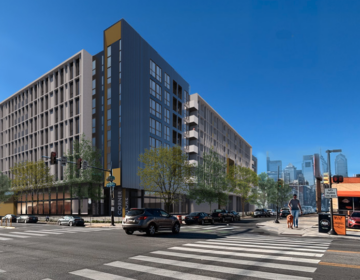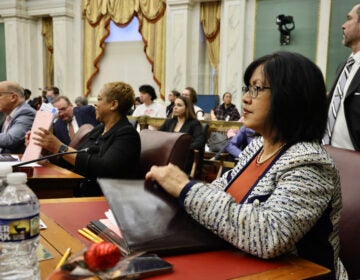Time’s up for a midcentury modern rec center by Philly’s first female architect
Philadelphia is demolishing a former rec center designed by Elizabeth Hirsh Fleisher to make for a new entrance to Columbus Square Park.

The round building at Columbus Square in South Philadelphia will be torn down as part of the park's renovation. (Emma Lee/WHYY)
South Philadelphia’s cylindrical tower is living out its final days.
Construction fences went up Monday at Columbus Square Park, where the midcentury modern roundhouse has attracted eyeballs since 1960. Designed by Philadelphia’s first registered female architect, the small stone building will be demolished in the coming weeks to make way for a new entrance to the park.
Grace Marchesani has lived in the red brick rowhouse across the street from Columbus Square Park for more than 70 years. She recalls playing ball in the park when it was still an open field.
“As a little girl, I would sit on the cement blocks … my dad would pick me up and put me on there, I was so little … and it was so beautiful, this neighborhood,” she said. “The park was all grass, and a circular cement design, and inside the cement design, all flowers.”
The pavilion was constructed later, after Marchesani was older. The 12-point, crown-like structure on the building’s roof, she said, was meant to evoke the folds of Columbus’s hat.
Even in the ‘60s, the structure was an unusual choice.
“You see it looks like — with the points, and it’s round,” Marchesani said, gesturing toward the building. “Kind of weird.”
A tiny tower that made history
Architect Elizabeth Hirsh Fleisher, best known for designing the modern brick Parkway House at 2201 Pennsylvania Ave., originally intended the round building to serve as the neighborhood’s senior center. But after the city built a new, larger rec center on the northeast corner of the park, the pavilion was taken out of commission. Aside from a short-lived stint as a weightlifting gym and occasional use as a storage shed, it’s stood idle since then. Still, Fleisher’s legacy alone was enough for some Philadelphians to justify keeping the tiny tower.
Inga Saffron, architecture critic for the Philadelphia Inquirer, said in March that the building’s loss, both as one of Fleisher’s few remaining works and as a marker of the city’s most dynamic midcentury modern designs, would be “a double blow for Philadelphia history.”
“The Columbus Square pavilion may be small, but that doesn’t mean it can’t find a use … our recreation buildings are too precious to discard so lightly,” Saffron wrote.
Dave Rumsey, member of the Columbus Square Advisory Council, said he doesn’t think it’s that serious. “[Fleisher’s] an important architect,” he said. “That doesn’t necessarily mean that this is an important building.”
Rumsey lives on Reed Street, less than a block away from the roundhouse. The park, he said, is “kind of my front lawn,” so he’s seen the pavilion fall into disrepair. In the eight years he’s been in the neighborhood, the dilapidated building is occasionally climbed by children or utilized for storage. But that’s all. “It’s kind of insignificant, in my opinion.”
Much more significant, he said, is the park’s redesign, conceptualized by neighborhood residents and business owners in tandem with the Community Design Collaborative. The renovation, estimated to cost $2.8 million, is funded by a grant from the William Penn Foundation as well as funding from the Passyunk Avenue Revitalization Corp. and the city. The neighborhood also raised thousands of dollars for the project, which includes construction of new walkways, benches, and lighting, various safety upgrades to the park’s two playgrounds, and expansion of the existing dog park. The work also includes sprayground fixes. Removing the pavilion will open up the square and, designers hope, create a more inviting green space for pedestrians.
Rumsey acknowledged that the roundhouse could have been spared in the park remake. But the community “couldn’t find anyone interested in fixing that roundhouse up to the point where it would meet code,” he said. “It’d be a lot of work.”
The current structure, as originally designed by Fleisher, has a singular access doorway that serves as both entrance and exit. That doesn’t fit the standards of the modern building code, which requires at least two. In the end, it came down to the cash. When the designers consulted the neighborhood, local residents decided that any possible benefits to including the pavilion would be outweighed by the overwhelming cost of redesigning and rebuilding the structure.
So Columbus’s crown had to go.
Alain Joinville, spokesman for Philadelphia Parks & Recreation, said the city doesn’t have an exact demolition date at this point. However, he added, “we do expect that demolition of the roundhouse will occur early in the site renovation process.”
Since renovation began Monday, the neighborhood can expect curvy walls to start falling soon.
In the meantime, Grace Marchesani is unbothered by the prospect of a redesigned Columbus Square. Not because she doesn’t have sentimental memories of it, but because she’s already watched the park change.
At 77, she is its oldest continuous neighbor. Her childhood neighbors have married, moved, or passed away. She was there when the pavilion was first erected, and she’ll be there when it’s demolished.
It’s all just part of the neighborhood.
WHYY is your source for fact-based, in-depth journalism and information. As a nonprofit organization, we rely on financial support from readers like you. Please give today.







